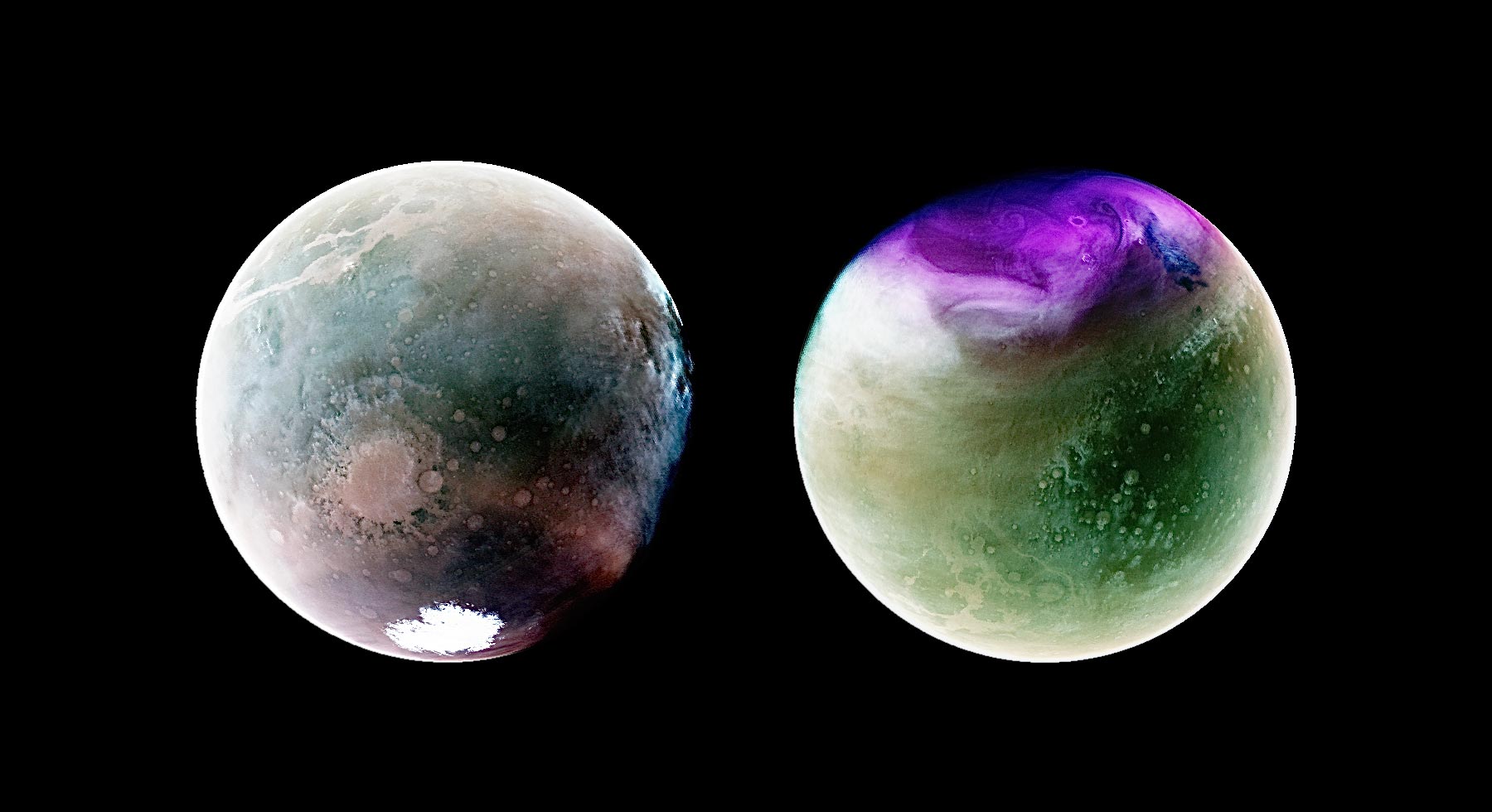
NASA の MAVEN ミッションは、2022 年と 2023 年に火星の軌道上のさまざまな地点で 2 つの素晴らしい紫外線画像を撮影し、火星の大気と季節の変化についての独自の洞察を提供しました。 これらの画像は、火星の大気喪失を理解するのに役立ち、その気候の歴史と居住可能性の可能性について情報を提供します。 クレジット: NASA/LASP/CU ボルダー
Mars, taken during opposite points in the planet’s orbit around the Sun in 2022 and 2023. These images, vividly colorized for visibility, give unique insights into the Martian atmosphere, seasonal changes, and surface details, contributing to the understanding of the planet’s climate history and potential habitability.
NASA’s MAVEN (Mars Atmosphere and Volatile EvolutioN) mission acquired stunning views of Mars in two ultraviolet images taken at different points along our neighboring planet’s orbit around the Sun.
By viewing the planet in ultraviolet wavelengths, scientists can gain insight into the Martian atmosphere and view surface features in remarkable ways.

This is an artist’s rendition of NASA”s Mars Atmosphere and Volatile Evolution, or MAVEN spacecraft orbiting Mars. Credit: NASA/GSFC
MAVEN’s Imaging Ultraviolet Spectrograph (IUVS) instrument obtained these global views of Mars in 2022 and 2023 when the planet was near opposite ends of its elliptical orbit.
The IUVS instrument measures wavelengths between 110 and 340 nanometers, outside the visible spectrum. To make these wavelengths visible to the human eye and easier to interpret, the images are rendered with the varying brightness levels of three ultraviolet wavelength ranges represented as red, green, and blue. In this color scheme, atmospheric ozone appears purple, while clouds and hazes appear white or blue. The surface can appear tan or green, depending on how the images have been optimized to increase contrast and show detail.

Martian Summer in Ultraviolet: The MAVEN spacecraft captures Mars’ southern hemisphere during its closest pass to the Sun, revealing a haze-filled Argyre Basin and a shrinking southern polar ice cap. Credit: NASA/LASP/CU Boulder
The first image was taken in July 2022 during the southern hemisphere’s summer season, which occurs when Mars passes closet to the Sun. The summer season is caused by the tilt of the planet’s rotational axis, similar to seasons on Earth. Argyre Basin, one of Mars’ deepest craters, appears at bottom left filled with atmospheric haze (depicted here as pale pink). The deep canyons of Valles Marineris appear at top left filled with clouds (colored tan in this image). The southern polar ice cap is visible at bottom in white, shrinking from the relative warmth of summer. Southern summer warming and dust storms drive water vapor to very high altitudes, explaining MAVEN’s discovery of enhanced hydrogen loss from Mars at this time of year.

Mars at its Farthest: The MAVEN mission unveils the northern hemisphere after Mars’ most distant point from the Sun, showcasing an ozone-rich winter scene and abundant white clouds. Credit: NASA/LASP/CU Boulder
The second image is of Mars’ northern hemisphere and was taken in January 2023 after Mars had passed the farthest point in its orbit from the Sun. The rapidly changing seasons in the north polar region cause an abundance of white clouds. The deep canyons of Valles Marineris can be seen in tan at lower left, along with many craters. Ozone, which appears magenta in this UV view, has built up during the northern winter’s chilly polar nights. It is then destroyed in northern spring by chemical reactions with water vapor, which is restricted to low altitudes of the atmosphere at this time of year.
MAVEN launched in November 2013 and entered Mars’ orbit in September 2014. The mission’s goal is to explore the planet’s upper atmosphere, ionosphere, and interactions with the Sun and solar wind to explore the loss of the Martian atmosphere to space. Understanding atmospheric loss gives scientists insight into the history of Mars’ atmosphere and climate, liquid water, and planetary habitability. The MAVEN team is preparing to celebrate the spacecraft’s 10th year at Mars in September 2024.
MAVEN’s principal investigator is based at the University of California, Berkeley, while NASA’s Goddard Space Flight Center in Greenbelt, Maryland, manages the MAVEN mission. Lockheed Martin Space built the spacecraft and is responsible for mission operations. NASA’s Jet Propulsion Laboratory in Southern California provides navigation and Deep Space Network support. The Laboratory for Atmospheric and Space Physics at the University of Colorado Boulder is responsible for managing science operations and public outreach and communications.

「アマチュア主催者。ビールの伝道者になりたい。一般的なウェブファン。認定インターネット忍者。熱心な読者。」






More Stories
スペースXのファルコン9ロケットが打ち上げ前に停止、億万長者が特別任務に就く
ブラックホールはどのようにしてこれほど大きく、そして速く成長したのでしょうか?答えは暗闇の中にあります
世界最速の顕微鏡が電子の動きをアト秒で捉える:ScienceAlert